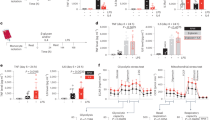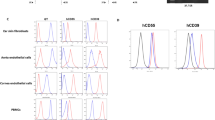Abstract
Coordinated expression of cell adhesion molecules and chemokines on the surface of vascular endothelium is responsible for the homing of immune effector cells to targeted sites. One way to attract non-activated immune cells to targeted organs is to use transgenically expressed adhesion molecules responsible for leukocyte recruitment. We have previously shown that polyethyleneimine (PEI) grafted with non-ionic amphiphilic Pluronic P123 block copolymer (P123PEI) modifies biodistribution of plasmid DNA toward the liver. In the present study, a P123PEI-formulated plasmid carrying the gene encoding for the murine ICAM-1 molecule was injected i.v. into transgenic ICAM-1-deficient mice. The RT-PCR analysis of ICAM-1 mRNA expression showed that P123PEI induced a dose-dependent expression of ICAM-1 in the liver. Furthermore, this expression of ICAM-1 induced neutrophil invasion in the liver, while no such invasion was observed in mice injected with formulated control plasmid or naked DNA. These results suggest that P123PEI allows functional transgene expression in the liver following i.v. injection and that ICAM-1 could be used to enhance immune response locally by attracting immune effector cells.
This is a preview of subscription content, access via your institution
Access options
Subscribe to this journal
Receive 12 print issues and online access
$259.00 per year
only $21.58 per issue
Buy this article
- Purchase on Springer Link
- Instant access to full article PDF
Prices may be subject to local taxes which are calculated during checkout


Similar content being viewed by others
References
Sligh JE Jr et al. Inflammatory and immune responses are impaired in mice deficient in intercellular adhesion molecule 1 Proc Natl Acad Sci USA 1993 90: 8529–8533
Xu H et al. Leukocytosis and resistance to septic shock in intercellular adhesion molecule 1-deficient mice J Exp Med 1994 180: 95–109
Kamochi M et al. P-selectin and ICAM-1 mediate endotoxin-induced neutrophil recruitment and injury to the lung and liver Am J Physiol 1999 277: 310–319
Marvin MR et al. Liver metastases are enhanced in homozygous deletionally mutant ICAM-1 or LFA-1 mice J Surg Res 1998 80: 143–148
Mei M et al. Measurement of serum circulating intercellular adhesion molecule-1 and its clinical significance in hepatocellular carcinoma: preliminary report J Hepatobiliary Pancreat Surg 1999 6: 181–185
Huang CC et al. Circulating intercellular adhesion molecule-1 in chronic liver disease and hepatocellular carcinoma Chung Hua I Hsueh Tsa Chih 1999 62: 487–495
Yoong KF, McNab G, Hubscher SG, Adams DH . Vascular adhesion protein-1 and ICAM-1 support the adhesion of tumor-infiltrating lymphocytes to tumor endothelium in human hepatocellular carcinoma J Immunol 1998 160: 3978–3988
Emoto M et al. Critical role of leukocyte function-associated antigen-1 in liver accumulation of CD4+NKT cells J Immunol 1999 162: 5094–5098
Kawamura T et al. Cytotoxic activity against tumour cells mediated by intermediate TCR cells in the liver and spleen Immunology 1996 89: 68–75
Seki S et al. Antimetastatic effect of NK1+ T cells on experimental haematogenous tumour metastases in the liver and lungs of mice Immunology 1997 92: 561–566
Okuno K et al. Involvement of liver-associated immunity in hepatic metastasis formation J Surg Res 1998 75: 148–152
Emoto M et al. Critical role of leukocyte function-associated antigen-1 in liver accumulation of CD4+NKT cells J Immunol 1999 162: 5094–5098
Ottonello L et al. FMLP- and TNF-stimulated monoclonal Lym-1 antibody-dependent lysis of B lymphoblastoid tumour targets by neutrophils Br J Cancer 1999 80: 331–337
Ottonello L et al. Monoclonal Lym-1 antibody-dependent cytolysis by neutrophils exposed to granulocyte-macrophage colony-stimulating factor: intervention of FcgammaRII (CD32), CD11b-CD18 integrins and CD66b glycoproteins Blood 1999 93: 3505–3511
Michon JM et al. In vivo induction of functional Fc gammaRI (CD64) on neutrophils and modulation of blood cytokine mRNA levels in cancer patients treated with G-CSF (rMetHuG-CSF) Br J Haematol 1998 100: 550–556
Cavallo F et al. Immune events associated with the cure of established tumors and spontaneous metastases by local and systemic interleukin 12 Cancer Res 1999 59: 414–421
Wen W et al. The generation of endostatin is mediated by elastase Cancer Res 1999 59: 6052–6056
Patterson BC, Sang QA . Angiostatin-converting enzyme activities of human matrilysin (MMP-7) and gelatinase B/type IV collagenase (MMP-9) J Biol Chem 1997 272: 28823–28825
Dean PA, Ramsey PS, Donohue JH, Nelson H . Microvascular expression of MALA-2 correlates with in vivo lymphocyte trafficking and is preferentially enhanced in tumors by tumor necrosis factor-alpha and interleukin-1 alpha Int J Cancer 1994 59: 639–645
Whitehead RP et al. Phase I trial of simultaneous administration of interleukin 2 and interleukin 4 subcutaneously Clin Cancer Res 1995 10: 1145–1152
Enzinger PC et al. Phase II clinical trial of 13-cis-retinoic acid and interferon-alpha-2a in patients with advanced esophageal carcinoma Cancer 1999 85: 1213–1217
Clark JI et al. Daily subcutaneous ultra-low-dose interleukin 2 with daily low-dose interferon-alpha in patients with advanced renal cell carcinoma Clin Cancer Res 1999 5: 2374–2380
Emtage PC et al. Adenoviral vectors expressing lymphotactin and interleukin 2 or lymphotactin and interleukin 12 synergize to facilitate tumor regression in murine breast cancer models Hum Gene Ther 1999 10: 697–709
Fushimi T, Kojima A, Moore MA, Crystal RG . Macrophage inflammatory protein 3alpha transgene attracts dendritic cells to established murine tumors and suppresses tumor growth J Clin Invest 2000 105: 1383–1393
Miller PW et al. Intratumoral administration of adenoviral interleukin 7 gene-modified dendritic cells augments specific antitumor immunity and achieves tumor eradication Hum Gene Ther 2000 11: 53–65
Nguyen HK et al. Evaluation of polyether-polyethyleneimine graft copolymers as gene transfer agents Gene Therapy 2000 7: 126–138
King PD et al. Novel isoforms of murine intercellular adhesion molecule-1 generated by alternative RNA splicing J Immunol 1995 154: 6080–6093
Takei F . Inhibition of mixed lymphocyte response by a rat monoclonal antibody to a novel murine lymphocyte activation antigen (MALA-2) J Immunol 1985 134: 1403–1407
Lewinsohn DM, Bargatze RF, Butcher EC . Leukocyte-endothelial cell recognition: evidence of a common molecular mechanism shared by neutrophils, lymphocytes, and other leukocytes J Immunol 1987 138: 4313–4321
Lagasse E, Weissman IL . Flow cytometric identification of murine neutrophils and monocytes J Immunol Meth 1996 197: 139–150
Moreau E et al. Interactions between red blood cells and a lethal, partly quaternized tertiary polyamine J Cont Rel 2000 64: 115–128
Hart SL et al. Lipid-mediated enhancement of transfection by a nonviral integrin-targeting vector Hum Gene Ther 1998 9: 575–585
Spragg DD et al. Immunotargeting of liposomes to activated vascular endothelial cells: a strategy for site-selective delivery in the cardiovascular system Proc Natl Acad Sci USA 1997 94: 8795–8800
Lee RJ, Huang L . Folate-targeted, anionic liposome-entrapped polylysine-condensed DNA for tumor cell-specific gene transfer J Biol Chem 1996 271: 481–8487
Hisayasu S et al. In vivo targeted gene transfer into liver cells mediated by a novel galactosyl-D-lysine/D-serine copolymer Gene Therapy 1999 6: 689–693
Han J, Lim M, Yeom YI . Receptor-mediated gene transfer to cells of hepatic origin by galactosylated albumin-polylysine complexes Biol Pharm Bull 1999 22: 836–840
Springer TA . Traffic signals for lymphocyte recirculation and leukocyte emigration: the multistep paradigm Cell 1994 76: 301–314
Archelos JJ et al. Suppression of experimental allergic neuritis by an antibody to the intracellular adhesion molecule ICAM-1 Brain 1993 116: 1043–1058
Isobe M, Yagita H, Okumura K, Ihara A . Specific acceptance of cardiac allograft after treatment with antibodies to ICAM-1 and LFA-1 Science 1992 255: 1125–1127
Toda K et al. Antisense intercellular adhesion molecule-1 (ICAM-1) oligodeoxyribonucleotide delivered during organ preservation inhibits posttransplant ICAM-1 expression and reduces primary lung isograft failure Circ Res 2000 86: 166–174
Feeley BT et al. Optimization of ex vivo pressure mediated delivery of antisense oligodeoxynucleotides to ICAM-1 reduces reperfusion injury in rat cardiac allografts Transplantation 2000 69: 1067–1074
Bennett CF et al. An ICAM-1 antisense oligonucleotide prevents and reverses dextran sulfate sodium-induced colitis in mice J Pharmacol Exp Ther 1997 280: 988–1000
Wang HH, Nance DM, Orr FW . Murine hepatic microvascular adhesion molecule expression is inducible and has a zonal distribution Clin Exp Metastasis 1999 17: 149–155
van Den Engel NK et al. Circulating forms of intercellular adhesion molecule (ICAM)-1 in mice lacking membranous ICAM-1 Blood 2000 95: 1350–1355
Sartor WM, Kyprianou N, Fabian DF, Lefor AT . Enhanced expression of ICAM-1 in a murine fibrosarcoma reduces tumor growth rate J Surg Res 1995 59: 66–74
D'Angelica M et al. Herpes simplex virus (HSV)-mediated ICAM-1 gene transfer abrogates tumorigenicity and induces anti-tumor immunity Mol Med 1999 5: 606–616
van Seventer GA et al. Analysis of T cell stimulation by superantigen plus major histocompatibility complex class II molecules or by CD3 monoclonal antibody: costimulation by purified adhesion ligands VCAM-1, ICAM-1, but not ELAM-1 J Exp Med 1991 174: 901–913
Altmann DM, Hogg N, Trowsdale J, Wilkinson D . Cotransfection of ICAM-1 and HLA-DR reconstitutes human antigen-presenting cell function in mouse L cells Nature 1989 338: 512–514
Acknowledgements
We gratefully acknowledge the technical assistance of Claire Beauchemin and Doris Legault. The support from the National Science Foundation (BES-9907281) and Nebraska Research Initiative (Gene Therapy) is essential for the studies on non-viral gene delivery systems in UNMC. Dr St-Pierre is a scholar of the Fonds de la Recherche en Santé du Québec.
Author information
Authors and Affiliations
Rights and permissions
About this article
Cite this article
Ochietti, B., Lemieux, P., Kabanov, A. et al. Inducing neutrophil recruitment in the liver of ICAM-1-deficient mice using polyethyleneimine grafted with Pluronic P123 as an organ-specific carrier for transgenic ICAM-1. Gene Ther 9, 939–945 (2002). https://doi.org/10.1038/sj.gt.3301716
Received:
Accepted:
Published:
Issue Date:
DOI: https://doi.org/10.1038/sj.gt.3301716
Keywords
This article is cited by
-
Self-assembled micellar aggregates based monomethoxyl poly(ethylene glycol)-b-poly(ε-caprolactone)-b-poly(aminoethyl methacrylate) triblock copolymers as efficient gene delivery vectors
Journal of Materials Science: Materials in Medicine (2010)



